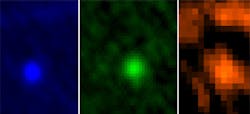Asteroid imaged in the infra-red
Scientists using the Herschel Space Observatory have made new observations of asteroid Apophis as it approached Earth this past weekend. The data show the asteroid to be bigger than first estimated, and less reflective.
Discovered in 2004, Apophis was initially thought to have a 2.7 percent chance of impacting Earth in 2029. Additional observations of the asteroid ruled out any possibility of an impact in 2029. However, Apophis is expected to make a record-setting -- but harmless -- close approach to Earth on April 13, 2029, when it comes no closer than 18,300 miles (29,450 kilometers) above Earth's surface.
Over the past weekend, the Herschel Space Observatory gathered data while observing Apophis for about two hours on its approach to Earth, ahead of its closest encounter at a little less than one-tenth of the distance from Earth to the sun, or about 9m miles (14.5 million kilometers).
The space observatory provided the first thermal infrared observations of Apophis at different wavelengths, which together with optical measurements helped refine estimates of the asteroid's properties. Previously, the asteroid's average diameter had been estimated at about 885 feet (270 meters). Herschel's observations indicate the space rock is about 10,060 feet (325 meters) across.
By analyzing the heat emitted by Apophis, Herschel also provided a new estimate of the asteroid's albedo -- a measure of its reflectivity-- of 0.23. This value means that 23 percent of the sunlight falling onto the asteroid is reflected, the rest is absorbed and heats up the asteroid. The previous albedo estimate for Apophis was 0.33.
The image above shows asteroid Apophis in three wavelengths: 70, 100 and 160 microns, respectively.
Herschel is a European Space Agency cornerstone mission, with science instruments provided by consortia of European institutes and with important participation by NASA. More information is online here.
Related stories from Vision Systems Design that you might also be interested in reading.
1. 3-D flash cameras destined to meet carbonaceous asteroid
3-D flash light detection and ranging (lidar) cameras developed by Advanced Scientific Concepts (ASC; Santa Barbara, CA, USA) have been chosen for the OSIRIS-REx planetary science mission that will return a sample of a carbonaceous asteroid to Earth in 2016.
2. Infrared imaging sensors to spot asteroid threats
The non-profit B612 Foundation has signed a contract with Ball Aerospace and Technologies (Broomfield , CO, USA) that will see engineers at Ball create prototype infrared imaging sensors for use on B612's Sentinel spacecraft which aims is to detect asteroids that might pose a threat to the Earth.
3. Dawn spacecraft captures image of asteroid with mountain bigger than Everest
A new image from NASA's Dawn spacecraft shows a mountain three times as high as Mount Everest in the south polar region of the giant asteroid Vesta, which resides between Mars and Jupiter.
-- Dave Wilson, Senior Editor, Vision Systems Design
